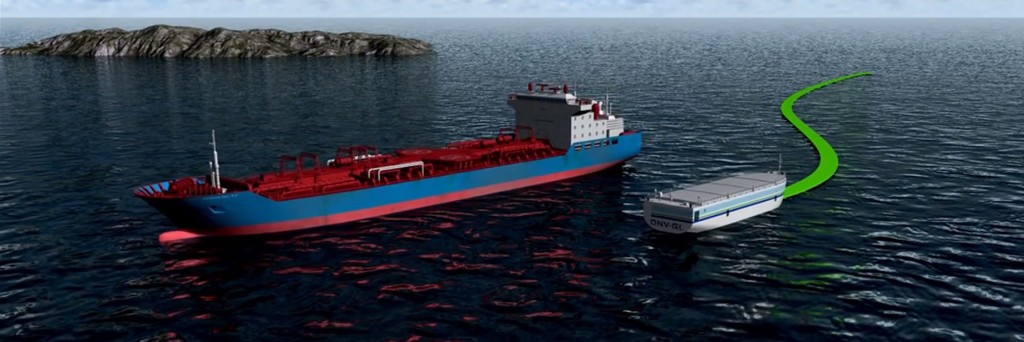Shipping focus: The ghosts of future shipping
Autonomous driving is not just for cars. The prospect of an unmanned ship transporting automotive cargo may not be so far fetched
It is possible that in the coming decades, more ghost ships will be found sailing the seas, with not a soul on board. This isn’t a repeat of the mysterious Marie Celeste, or an eternally condemned captain aboard the Flying Dutchman. Rather, it is the potential for unmanned ships that could deliver cargo around the world, including automotive parts and vehicles.
![]() Interest in autonomous-driving technology has risen not just in passenger cars, but for trucks too (click here for more on driverless trucks) and the concept took to the seas around a decade ago. However, while the technology may already be advanced, the feasibility of autonomous shipping rests on many factors on and offshore.
Interest in autonomous-driving technology has risen not just in passenger cars, but for trucks too (click here for more on driverless trucks) and the concept took to the seas around a decade ago. However, while the technology may already be advanced, the feasibility of autonomous shipping rests on many factors on and offshore.
Click on the links below to read the different articles that make up this report.
Firstly, changes to international laws would be needed to allow fewer or no crew members on larger ships. Beyond that, shippers and operators would need to trust such technology to guard against loss of jobs, piracy and managing vessels in difficult conditions.
For some logistics and ro-ro carriers, the prospect might seem too distant a prospect to take seriously – one deep-sea ro-ro company calls the idea “rather far fetched” – and indeed, some experts predict it will be at least 20-30 years, if not 50, before unmanned ships are seen in waters.
Others, however, see the technology emerging much sooner, even within the decade, and some experts see particular scope for automotive shipping. “I think if there is one shipping industry sector that might be interested to take the initiative, it would be the car carrier industry, because they are serving cargo shipments that are at the forefront of automation; the autonomous car itself,” reasons Dirk Visser, senior shipping consultant at Dynamar.
Some shipping lines are even looking into such possibilities already. Costantino Baldissara, director of commercial, logistics and operations at Italy’s Grimaldi Group, says the company has been following and supporting the development of unmanned ship technology. “The Grimaldi Group has a research department that is working on the development of projects that have the most advanced automation techniques,” he says. “We are convinced the future is going towards total efficiency and only a massive use of automation on board could help to achieve this aim.”
Nevertheless, Baldissara cautions shipping lines and regulators on moving too fast to adopt such technology. “Our position is for a moderate and rational reduction of crew numbers on board, encouraging the development of automation and use of unmanned ships,” he says.
The changing tide
In some ways, that would appear to be the direction in which shipping technology is moving. According to a report by Oskar Levander, vice-president of innovation, engineering and technology at Rolls-Royce Holdings’ Marine division, more functions are moving from ships to shore, such as engine and equipment monitoring, and some underwater operations. Most ships have cameras to help navigation at night or in bad conditions and systems are available that can transmit large amounts of data to shore.
Levander envisages moving captains into offices, where they could operate several ships at once, monitor their whereabouts and take over for docking using the ship’s cameras. Visser agrees this could work: “You could have a mix, with a much smaller crew and the captain taking over the steering of the autonomous ship for some aspects.”
Rolls-Royce is currently testing the autonomous technology and has said it will be used for bulk cargo vessels. Others have already pointed to the potential of autonomous technology for ro-ro and automotive logistics, including a model ship unveiled only this past year by researchers at DNV GL, a Norwegian-based ship and offshore classification society.
As with other forms of automation, the benefits would include lower labour costs for shipping lines. According to consultancy firm Moore Stephens, around 44% of freight shipping costs are related to crew. Eliminating living quarters and other crew areas would add more cargo capacity, while functions such as air conditioning and lifeboats could be reduced as well. Along with the extra space, such changes would make ships around 5% lighter before loading, which would help save fuel costs.
According to Rolls-Royce, autonomous deep-sea journeys would cut operating costs, burn less fuel and reduce emissions. As shipping lines face high running costs, including for low-sulphur fuel in emission control areas in Europe and North America, such reductions would certainly be welcome.

Research points to ro-ro potential
There are a number of research projects involving autonomous shipping, including EU-funded MUNIN (Maritime Unmanned Navigation through Intelligence in Networks). Now in its third and final year, MUNIN is preparing for simulation runs to test the concept, according to Hans-Christoph Burmeister, MUNIN project coordinator at the Fraunhofer Center for Maritime Logistics and Services. “The aim of MUNIN is not to develop a new vessel, but a concept to enable vessels to act autonomously by making use of the newly developed intelligence,” he says.
This concept features an advanced sensor system that uses existing devices already fitted on ships today, complemented by a surveillance camera unit developed by one of MUNIN’s project partners. “The system gathers all information and fuses related values to improve data quality and information reliability,” Burmeister explains.
The technology could be applied to ships of any size, and focuses on long passages, which could be useful for transporting vehicles and automotive cargo. The concept focuses on bulk vessels with their specific demands. The transport of automotive cargo has different logistical parameters and demands, but the more autonomous concepts are realised, the more complex their capability will become.
According to Burmeister, slower operation of vessels could also result in fuel savings of 50%, although this could be disruptive for industries such as automotive which have tight deadlines and high pressure on delivery.
Another interesting project is DNV GL’s ‘ReVolt’ vessel, which the company built on a 1:20 scale model to test its capabilities. ReVolt can navigate independently using technologies such as GPS, radar and cameras, creating a “multisensory perception field” around the vessel, according to Hans-Anton Tvete, senior researcher for maritime transport at DNV GL’s Strategic Research and Innovation unit. “The Revolt will also utilise port charts so that it doesn’t get caught in sandbanks,” he explains.
Although ReVolt is only a scale model, its findings could be used on larger ships. “The technology is available in the market today. It’s not something new and is already demonstrated by driverless cars like the Google car,” Tvete says. “However, the technology must be integrated into a maritime setting and field tested.”
Tvete believes the ReVolt technology could be used in areas such as short-sea ro-ro shipping or moving cars in containers. “While that particular ship is not designed for ro-ro cargo, the ReVolt still has the potential to transport cargo in the ro-ro segment,” he says. “The ship is rather slow, but we believe with frequent departures, high availability and developing the functionality, it can operate in the ro-ro segment as well.”
However, a possible limitation could be the battery technology, as its size and the density may not support the range and speed required by the vessels. ReVolt’s battery has a range of 100 nautical miles, before needing to be recharged.
Safety, security and reality
There are some concerns in the shipping industry about how safe and secure unmanned vessels would be. DNV GL’s Tvete suggests that safety would actually be a benefit of the ReVolt project. “Some studies show that around 85% of accidents at sea are due to human error in some way. We believe that increasing the level of automation has the potential to mitigate some of these errors. The ReVolt ship has dynamic positioning capabilities, a high degree of manoeuvrability and can stay put as a fail-safe mechanism,” Tvete says.
He does, however, acknowledge that the lack of human intervention could make shipping and routing less flexible. “Unmanned ships would follow navigational routes and anti-collision regulations more strictly, but manned ships can agree among themselves to deviate from the routes,” he adds.

While some highlight that an unmanned ship would not be able to respond to distress signals from other vessels, or notice other ships, according to research by Rolls-Royce, automated ships would face less traffic and slower speeds compared to driverless cars or drone aircraft. If the ships get into any difficulty, or lose connection with land, they would go into safe mode and await rescue. Current projects are all testing a range of scenarios, including bad weather, to evaluate safety.
Costantino Baldissara also points to concerns over pirates and computer hacking in unmanned ships. “[Autonomous] ships may be more vulnerable and subject to easier pirate attacks, and it would be easier to control the computers from hackers, hijacking the vessel at will,” he says.
Tvete, however, does not believe that piracy would be a major concern; for one thing, the DNV GL project is aimed at ships navigating close to shore. Also, by eliminating crew members, unmanned ships could remove the impetus for some piracy. “Lately, piracy has mostly been concerned with demanding ransom for crew, so obviously that wouldn’t be the case for an unmanned ship. There has to be some kind of shore support, in terms of sea traffic management, and a continuous camera feed, so [safety] should be easily monitored,” he says.
For deep-sea unmanned vessels, the design of the ship could also be altered to make it more difficult to board. As there would be no crew, the ship would not require access points, for example.
Legislative limbo
Oskar Levander’s Rolls-Royce report suggests autonomous ships could become a reality within this decade. If they do, however, they might not be legal. Natalie Brown, media and communications officer at the International Maritime Organisation (IMO), says the ultimate decision on the legality of unmanned ships would be down to the ship’s flag state. However, the IMO’s Safety of Life at Sea (SOLAS) convention states: “All ships shall be sufficiently and efficiently manned.” Any governments sanctioning unmanned ships would have to demonstrate that they have met this requirement under their relevant legal systems.
“The flag state would have to justify issuing it with a Safe Manning Certificate, in order for it to trade,” Brown says.
"[Autonomous] ships may be more vulnerable and subject to easier pirate attacks, and it would be easier to control the computers from hackers, hijacking the vessel at will" - Costantino Baldissara, Grimaldi Lines
However, there is no specific mention of unmanned ships in IMO treaties, putting the technology in a kind of limbo. Brown explains that adding guidance would require an official submission from UN members. “I am not aware of any submissions to IMO regarding unmanned vessels. It would need a member state to raise this as an issue and to propose the adoption of regulations or guidance.”
Costantino Baldissara suggests that even if legal minimum crew requirements were to change, handling vehicles and ro-ro cargo would likely continue to require a certain crew size for the foreseeable future. “We are of the opinion that in ro-ro operated vessels, it will be impossible to reduce the number of crew below some limits, due to problems arising from the type of cargo, stowage and control of the vessel in sailing conditions,” he says.
Industry acceptance
While many OEMs may have future-technology departments responsible for developing autonomous cars, this is a little more unusual for the logistics industry, making the concept of an unmanned ship transporting automotive cargo seem a distant dream for many companies, if they have even considered it.

Nevertheless, some companies are looking forward to the cost and operational improvements such technology could bring. “The technological impact involves the sailing safety conditions, due to better self-control of all involved components, the main engines, propulsion devices and navigation equipment,” says Baldissara. “The challenge for the future is to equip unmanned ships by constant and comprehensive computer monitoring to anticipate failures in advance, and for redundant systems to kick in, similar to those on aeroplanes.”
Hans-Christoph Burmeister anticipates relatively swift progress in the shipping sector. “The shipping industry is a very global one and common international legislation develops at a modest pace, but if a number of countries would push forward to enable autonomous shipping, it is not unlikely to see legislative adaptions in the future.”
Dynamar’s Dirk Visser also sees further automation as inevitable. “Over the last 50 years we have seen things happening that we never thought would be possible, and although it may currently be on a much smaller scale, automation is all around us... In general I think if it can be done, it will ultimately happen.”
Before any widespread adoption of automated shipping, OEMs and suppliers would need to be convinced that their cargo is as secure as with a manned vessel, and that the potentially reduced speed of deep-sea vessels would not affect the supply chain. Once that happens, it may not be as long as some think before autonomous ships are carrying vehicles or parts. As Rolls-Royce’s Oskar Levander writes: “Sometimes what was unthinkable yesterday is tomorrow’s reality.”







